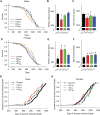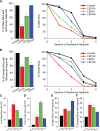IGF-1 has sexually dimorphic, pleiotropic, and time-dependent effects on healthspan, pathology, and lifespan
- PMID: 28409331
- PMCID: PMC5411370
- DOI: 10.1007/s11357-017-9971-0
IGF-1 has sexually dimorphic, pleiotropic, and time-dependent effects on healthspan, pathology, and lifespan
Abstract
Reduced circulating levels of IGF-1 have been proposed as a conserved anti-aging mechanism that contributes to increased lifespan in diverse experimental models. However, IGF-1 has also been shown to be essential for normal development and the maintenance of tissue function late into the lifespan. These disparate findings suggest that IGF-1 may be a pleiotropic modulator of health and aging, as reductions in IGF-1 may be beneficial for one aspect of aging, but detrimental for another. We postulated that the effects of IGF-1 on tissue health and function in advanced age are dependent on the tissue, the sex of the animal, and the age at which IGF-1 is manipulated. In this study, we examined how alterations in IGF-1 levels at multiple stages of development and aging influence overall lifespan, healthspan, and pathology. Specifically, we investigated the effects of perinatal, post-pubertal, and late-adult onset IGF-1 deficiency using genetic and viral approaches in both male and female igf f/f C57Bl/6 mice. Our results support the concept that IGF-1 levels early during lifespan establish the conditions necessary for subsequent healthspan and pathological changes that contribute to aging. Nevertheless, these changes are specific for each sex and tissue. Importantly, late-life IGF-1 deficiency (a time point relevant for human studies) reduces cancer risk but does not increase lifespan. Overall, our results indicate that the levels of IGF-1 during development influence late-life pathology, suggesting that IGF-1 is a developmental driver of healthspan, pathology, and lifespan.
Keywords: Aging; Cancer; Insulin-like growth factor-1; Longevity; Pathology; Somatomedin C.
Figures





References
-
- Amato G, et al. Body composition, bone metabolism, and heart structure and function in growth hormone (GH)-deficient adults before and after GH replacement therapy at low doses. J Clin Endocrinol Metab. 1993;77:1671–1676. - PubMed
Publication types
MeSH terms
Substances
Grants and funding
LinkOut - more resources
Full Text Sources
Other Literature Sources
Miscellaneous

